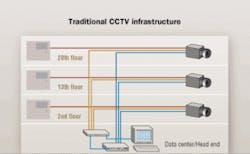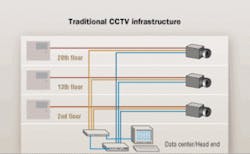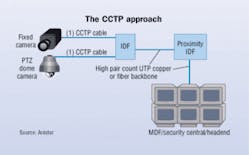Historically, the growth and expansion of security video-camera systems were hindered due to invasion-of-privacy concerns. With today’s extremely heightened consciousness of terrorist threats, exemplified most recently by the commuter underground attacks in London this past summer, privacy issues no longer pose a significant concern. In London, where surveillance cameras pervade, the use of video to identify the King’s Cross suicide bombers proved invaluable.
As a result, many large metropolitan transportation systems in the United States, such as the New York City subway system, are now evaluating a major expansion of their current, limited systems. This significant trend is expected to stimulate growth in sales of fiber cabling, which is primarily used in these large, often-far-reaching systems.
Other factors also will contribute to growth in the market for cabling systems that support security video cameras. Digital networking cameras are one such factor, and will foster the use of UTP structured cabling systems. These newer, digital-technology cameras take a direct UTP connection rather than the older-technology analog cameras, which use coaxial cabling.
With older analog technology, coaxial cabling was used throughout the system. Adding a video camera within this type of architecture requires running a new coaxial cable to the camera’s location, which could be significantly costly, particularly if the camera is a long distance away from the system’s controller. Generally, this architecture does not lend itself to moves, adds, or changes (MACs) without a central cable-management panel.
In a newer, digital-technology architecture, less-expensive and easier-to-handle UTP cabling takes the place of coaxial. The setup is a true structured cabling system, in which the horizontal cabling, rather than being terminated to a workstation outlet, is terminated to a plug that goes directly into the video camera. The cabling is then run into a UTP patch panel, just as you see in traditional TIA/EIA-568-B-style commercial building structured cabling systems.
This approach and topology provide a centralized cable-management panel for readily effecting MACs. In addition to the advantage of less-costly MACs, the newer digital approach provides many other benefits attractive to information-technology (IT) departments, including (and perhaps most notably) the ability to merge the video signals with the system’s primary databases for identification purposes. In effect, the security video camera system is becoming another subnet on the main Ethernet network. Digital video, along with digital signal and voice, can be combined to provide an all-digital information database. One other advantage of this digital system is the ability to provide video signals remotely, on demand, via the Internet.
A new study examining this market evolution forecasts the three major types of cabling used in these systems: coaxial, UTP, and fiber. The study forecasts that UTP cabling will have the highest growth among the three for this application in particular, at 34.1%; however, fiber cabling projects will be the largest overall market, at $1.2 billion by 2010.
The reason the overall fiber market is the largest is that the cabling systems used in transportation systems-railroads, airports, subways, large sports complexes, amusement parks, and others-tend to be extremely large systems, typically with hundreds of video cameras. Additionally, the need for media converters on each fiber cable adds to fiber’s overall market size. In fact, this niche provides one of the largest markets for media-converter suppliers.
FRANK MURAWSKI is president of FTM Consulting Inc. (www.ftmconsultinginc.com), a market research and analysis firm.
Twisted-pair infrastructure in security systemsThe recently published report by Frank Murawski, author of this month’s Perspective column, looks at digital security systems and the infrastructure that support them, including unshielded twisted-pair (UTP) cabling. The report projects these market segments’ growth (for UTP and fiber) and recession (for coaxial) out to 2010.
While the market for UTP and/or fiber-based video appears to be emerging, fiber- and copper-based security systems have been available within the structured cabling marketplace literally for years. In January 2003, Anixter (www.anixter.com) introduced CCTP-closed circuit over twisted-pair. The system introduced many in the market to the concept of running video/security signals over UTP as opposed to coaxial.
The first illustration (Traditional CCTV infrastructure) is a traditional, analog surveillance system supported by coaxial-cabling home runs that, as the drawing indicates, may reach as far as 20 or more floors of a building. Such a system requires separate wiring runs for control and power to each camera as well. The second illustration (The CCTP approach) depicts Anixter’s proprietary CCTP system, which employs a similar architecture to the “structured” approach Murawski details in his column.
Based on Murawski’s projections, Anixter’s CCTP system and other, similar video-over-twisted-pair systems will pervade in the market over the next five years.-PM


